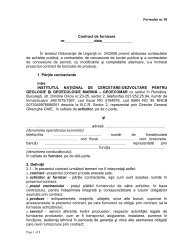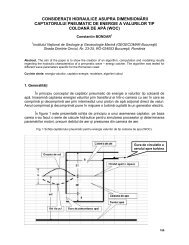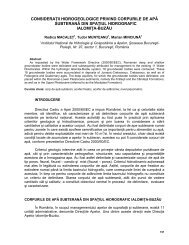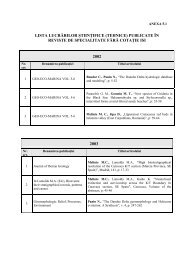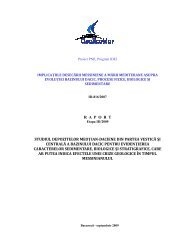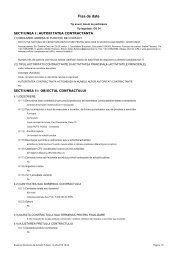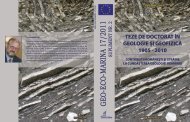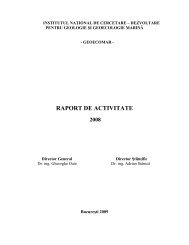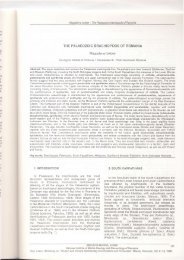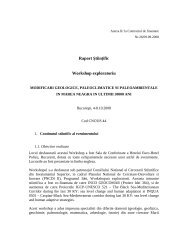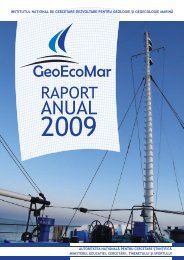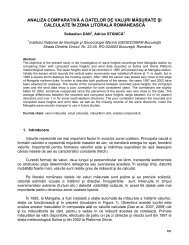Maeotian / Pontian ostracods in the Badislava ... - GeoEcoMar
Maeotian / Pontian ostracods in the Badislava ... - GeoEcoMar
Maeotian / Pontian ostracods in the Badislava ... - GeoEcoMar
Create successful ePaper yourself
Turn your PDF publications into a flip-book with our unique Google optimized e-Paper software.
A. Floroiu, M. Stoica, I. Vasiliev, W. Krijgsman – <strong>Maeotian</strong> / <strong>Pontian</strong> <strong>ostracods</strong> <strong>in</strong> <strong>the</strong> <strong>Badislava</strong> –Topolog area<br />
Fig. 2. Litho-facial aspects of <strong>Maeotian</strong> deposits from <strong>Badislava</strong> Valley section; a) Fluvial deposits with sands and gravel lenses; b) Small channel<br />
cut on flood pla<strong>in</strong> deposits; on <strong>the</strong> edge of <strong>the</strong> channel, can be observed fossil roots <strong>in</strong> orig<strong>in</strong>al position; c) Interbedded blackish fossil soils and<br />
flood-pla<strong>in</strong> silts; d) Erosional contact between Upper <strong>Maeotian</strong> flood-pla<strong>in</strong> deposits and Upper <strong>Pontian</strong> littoral sands and f<strong>in</strong>e gravels<br />
represented by gray or brownish clays and silts with frequent<br />
calcareous concretions, as well as blackish layers rich <strong>in</strong> plant<br />
debris. They are very scarce <strong>in</strong> fossil rema<strong>in</strong>s, only few bad preserved<br />
shells of cont<strong>in</strong>ental or freshwater gastropods (species<br />
of Helicidae and Planorbidae) and bivalves (species of Unionidae)<br />
have been observed (Stoica et al., 2007). The microfauna<br />
is represented by few species of fresh water <strong>ostracods</strong>:<br />
Candoniella sp.; Candona sp.; Paracandona albicans (Brady);<br />
Ilyocypris bradyi Sars (Fig 4, Plate 1). These species populated<br />
unstable environments, such as lakes, rivers with temporary<br />
existence and flood-pla<strong>in</strong>s. Paracandona albicans, (<strong>the</strong> adult<br />
specimens show reticulate valves easy to be confused with<br />
juveniles of Pseudocandona Kaufman), lives <strong>in</strong> fresh-water rivers,<br />
lakes and pools. In <strong>the</strong> Dacian Bas<strong>in</strong>, it has been described<br />
<strong>in</strong> <strong>the</strong> <strong>Maeotian</strong>, Dacian and Romanian fresh water sediments<br />
associated with Cyprideis heterostigma sublittoralis and Cyclocypris<br />
sp (Olteanu <strong>in</strong> Papaianopol et al., 1987; Olteanu, 1995).<br />
This scarce <strong>Maeotian</strong> ostracod fauna from <strong>in</strong>vestigated area<br />
differs essentially from <strong>the</strong> diversified one of <strong>the</strong> same stage<br />
from zones that evolved <strong>in</strong> bas<strong>in</strong>al conditions.<br />
Above <strong>the</strong> erosional surface, <strong>the</strong> <strong>Pontian</strong> starts with sands<br />
and silts, that frequent present wave ripples structures, which<br />
pass to more f<strong>in</strong>e-gra<strong>in</strong>ed deposits <strong>in</strong> <strong>the</strong> upper part. The f<strong>in</strong>egra<strong>in</strong>ed<br />
sediments provided a rich ostracod fauna, <strong>in</strong>dicative<br />
of <strong>the</strong> Upper <strong>Pontian</strong> (Bosphorian): Amplocypris dorsobrevis<br />
Sokac; Scottia sp.; Cypria tocorjescui Hanganu; Candona (Caspiocypris)<br />
ex. gr. alta (Zal.); Candona (Caspiolla) osso<strong>in</strong>ae Krst.;<br />
Candona (Caspiolla) venusta (Zal.); Candona (Pontoniella) acum<strong>in</strong>ata<br />
striata Mandelstam; Candona (Pontoniella) excellentis<br />
Olteanu; Candona (Pontoniella) sp.; Candona neglecta Sars;<br />
Bakunella dorsoarcuata (Zal.); Bakunella sp.; Cyprideis sp.1;<br />
Cyprideis sp. 2; Tyrrhenocy<strong>the</strong>re filipescui (Hanganu); Tyrrhenocy<strong>the</strong>re<br />
motasi Olteanu; Tyrrhenocy<strong>the</strong>re sp.1; Tyrrhenocy<strong>the</strong>re<br />
sp.2; Leptocy<strong>the</strong>re (Amnicy<strong>the</strong>re) palimpsesta Liv.; Leptocy<strong>the</strong>re<br />
Geo-Eco-Mar<strong>in</strong>a 17/2011<br />
239



